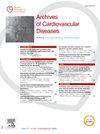SERCA3在小鼠主动脉α - 1肾上腺素受体介导的钙信号传导中的作用及其与NO通路的潜在相互作用
IF 2.3
3区 医学
Q2 CARDIAC & CARDIOVASCULAR SYSTEMS
引用次数: 0
摘要
血管张力的调节是平滑肌细胞(SMC)收缩和舒张之间的平衡。钙在这些过程中起着关键作用,而Sarco/内质网Ca2±atp酶(SERCAs)泵对调节钙稳态至关重要。虽然SERCA2是血管系统中的主要亚型,但SERCA3也在SMC和内皮细胞中共定位,这就提出了SERCA3在血管钙调节中的具体作用的问题。我们的目的是研究serca3依赖性钙信号在小鼠主动脉血管舒缩调节中的作用。方法采集野生型(WT)和serca3缺陷型(KO)雄性小鼠的血管张力,通过离体肌图研究血管张力。Western blot检测主动脉裂解液蛋白表达。用负载Fura-2探针(1 μM)的荧光显微镜观察新鲜分离的主动脉SMC的胞质钙水平。结果SERCA3缺失导致α - 1肾上腺素受体激动剂(phenylephrine, PE)的收缩反应特异性降低,但α - 1肾上腺素受体的表达未发生改变。有趣的是,用L-NAME抑制eNOS可以消除WT和KO主动脉之间pe诱导收缩的差异。此外,与WT主动脉相比,PE刺激期间KO的eNOS磷酸化(S1177)更高。总的来说,这表明KO动脉中no依赖性PE反应的抑制控制增加。此外,我们还研究了细胞内钙储存和细胞外钙流入对PE收缩反应的贡献。使用无钙细胞外溶液和钙通道阻滞剂(维拉帕米分别用于l型钙通道(LTCC)和2APB分别用于储存操作钙通道(SOCE)抑制),我们提出KO中pe收缩的减少是由于通过LTCC和SOCE的钙流入减少。这种改变与LTCC或TRPC5表达的变化无关。最后,我们发现,与WT主动脉相比,SERCA3-KO新鲜分离的SMC对PE反应的钙动员减少。结论在小鼠主动脉中,SERCA3通过钙内流(LTTCs和soce)和内皮no相关的舒张通路调节α - 1肾上腺素能依赖性收缩功能。本文章由计算机程序翻译,如有差异,请以英文原文为准。
Role of SERCA3 in calcium signaling mediated by α1-adrenoceptors and potential interaction with the NO pathway in mouse aorta
Introduction
Regulation of vascular tone is a balance between contraction and relaxation of smooth muscle cells (SMC). Calcium plays a key role in these processes, and the Sarco/Endoplasmic Reticulum Ca2 ± ATPases (SERCAs) pumps are crucial to regulate calcium homeostasis. While SERCA2 is the predominant isoform in the vascular system, SERCA3 is also co-localized in both SMC and endothelial cells, raising the question of the specific role of SERCA3 in vascular calcium regulation.
Objective
Our objective is to investigate the role of SERCA3-dependent calcium signaling in the regulation of mouse aorta vasomotion.
Method
Aortas were collected from wild-type (WT) and SERCA3-deficient (KO) male mice and vascular tone was studied by ex vivo myography. Western blot was used to evaluate protein expression in aorta lysates. Cytosolic calcium levels were studied by epifluorescence microscopy in freshly-isolated aortic SMC loaded with the Fura-2 probe (1 μM).
Results
Deletion of SERCA3 leads to a decrease in contractile response specifically to α1-adrenoceptor agonist (phenylephrine, PE) without alteration of the α1-adrenoceptor expression. Interestingly, inhibition of eNOS with L-NAME abolishes this difference in PE-induced contraction between WT and KO aorta. In addition, eNOS phosphorylation (S1177) during PE stimulation is higher in KO compared to WT aortas. Overall, this suggests an increase in the NO-dependent inhibitory control of PE response in KO arteries. Furthermore, contribution of intracellular calcium stores and extracellular calcium influx to PE contractile response were investigated. Using a calcium free extracellular solution and calcium channel blockers (verapamil for L-type calcium channels (LTCC) and 2APB for Store-Operated Calcium Entry (SOCE) inhibition, respectively), we propose that the decreased PE-contraction in KO is due to a reduced calcium influx through LTCC and SOCE. This alteration is not associated to changes in LTCC or TRPC5 expression. Finally, we showed that calcium mobilization in response to PE is reduced in freshly-isolated SMC from SERCA3-KO compared to WT aorta.
Conclusion
Our findings suggest that in mouse aorta, SERCA3 regulates the α1-adrenergic-dependent contractile function through modulation of calcium influx (by LTTCs and SOCEs) and the endothelial NO-related relaxing pathway.
求助全文
通过发布文献求助,成功后即可免费获取论文全文。
去求助
来源期刊

Archives of Cardiovascular Diseases
医学-心血管系统
CiteScore
4.40
自引率
6.70%
发文量
87
审稿时长
34 days
期刊介绍:
The Journal publishes original peer-reviewed clinical and research articles, epidemiological studies, new methodological clinical approaches, review articles and editorials. Topics covered include coronary artery and valve diseases, interventional and pediatric cardiology, cardiovascular surgery, cardiomyopathy and heart failure, arrhythmias and stimulation, cardiovascular imaging, vascular medicine and hypertension, epidemiology and risk factors, and large multicenter studies. Archives of Cardiovascular Diseases also publishes abstracts of papers presented at the annual sessions of the Journées Européennes de la Société Française de Cardiologie and the guidelines edited by the French Society of Cardiology.
 求助内容:
求助内容: 应助结果提醒方式:
应助结果提醒方式:


